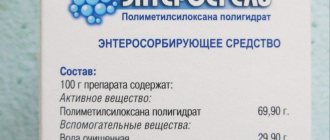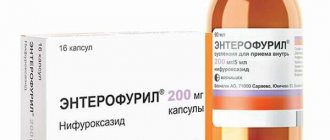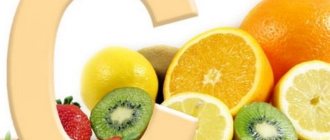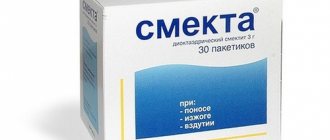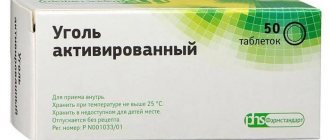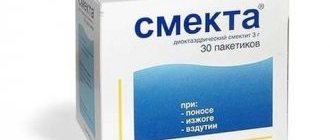- Latin name: Motilium
- ATX code: A03FA03
- Active ingredient: Domperidone
- Release form: tablets, suspension
Price from: 430 rub.
Antiemetic, central antagonist of dopamine receptors. The active ingredient is domperidone. The principle of action is based on blocking central and peripheral dopamine receptors in the trigger zone of the brain. The drug increases the motor and evacuation activity of the stomach, eliminates the inhibitory effect of dopamine on the motor function of the digestive system.
Motilium eliminates nausea, soothes hiccups, has an antiemetic effect, and increases the level of prolactin in the blood.
Motilium is available in the form of a suspension, in tablet form.
Indications for use
Before taking the drug in an infant, it is imperative to make sure that regurgitation is not vomiting caused by poisoning or infectious and inflammatory diseases of the digestive tract. Otherwise, there is a risk of harm rather than helping. Suppressing vomiting will lead to the accumulation of toxic products and microorganisms, which will worsen the child's condition.
Motilium can be used for poisoning in children accompanied by vomiting, only in combination with drugs that remove toxic products from the body. Most often, sorbents (Smecta, Enterosgel) are used as such preparations. You must understand that the simultaneous use of Motilium and these drugs will reduce the effect of the first, so the difference in the time of administration should be at least 20 minutes.
Motilium enhances gastric motility, activates peristalsis of the esophagus and duodenum, and produces an antiemetic effect. Thanks to this, the retention time of food masses in the gastrointestinal tract is reduced. It is noted that in children, domperidone helps eliminate constipation, normalizing bowel movements.
Important! Taking Motilium should be agreed with your doctor.
What can Motilium help a child with:
- regurgitation syndrome;
- increased gas formation, feeling of bloating;
- vomiting and nausea caused by indigestion;
- nausea and vomiting of organic, infectious or functional origin;
- motility disorders of the upper digestive tract.
Regurgitation often bothers newborns. Most often, they are caused by physiological characteristics and do not require special treatment. If regurgitation is persistent, profuse and negatively affects the baby’s weight gain, the pediatrician may prescribe a special diet that includes anti-reflux mixtures or medications, one of which may be Motilium. In addition to newborns, Motilium can be prescribed by a doctor to children with nausea and vomiting.
special instructions
A one-time dose of Motilium Express by people with kidney diseases does not require medical supervision, but the maximum dose should not exceed 2 tablets per day. In some cases, the amount of product should be reduced.
At the age of 60 years and over and if treated inappropriately, domperidone can lead to ventricular arrhythmia or death.
You should take the drug with caution in case of conduction disorders, problems with electrolyte balance, bradycardia and diseases of the heart muscle.
Motilium Express should be combined with Cytochrome P450 3A4 inhibitors (Indinavir) under medical supervision in order to promptly notice the occurrence of adverse reactions. You also need to carefully combine the drug with drugs for fungus, malaria, arrhythmia and tumors, with antipsychotics and drugs for the treatment of the gastrointestinal tract.
You should not take tablets if phenylalanine metabolism is impaired due to the content of aspartame.
Motilium Express can be purchased only with a prescription and stored at room temperature (up to 25 °C). Shelf life: 24 months.
How does it affect the body? (Pharmacodynamics)
Domperidone, which is contained in each tablet of the drug, blocks access of dopamine to D2 receptors. Under the influence of dopamine, peristalsis in the gastrointestinal tract slows down, the esophageal sphincter relaxes, blocking access to the esophagus of gastric juice. There is a reflux of contents from the stomach into the esophagus, from the duodenum into the stomach (both of these often cause heartburn). When the receptors are blocked by droperidone, dopamine cannot connect to them. As a result, it develops:
- increased motility of the gastrointestinal tract, especially the antrum of the stomach, duodenum;
- tight closure of the lower esophageal and pyloric sphincters.
The evacuation of partially digested food from the stomach to the duodenum and small intestine is improved and accelerated. In addition, droperidone blocks receptors in the vomiting center, which are activated by chemical agents. It reduces nausea and stops vomiting. In the body, 90–99% of the drug is metabolized in the intestinal wall and liver. Only 1–10% is excreted unchanged by the kidneys.
We recommend reading: Gastric lavage: algorithm for children and adults, lavage at home
Overdose
Exceeding the dose of Motilium Express is accompanied by convulsions, agitation, drowsiness, impaired coordination and orientation in space. It occurs more often in children and requires urgent gastric lavage with plenty of water and activated carbon therapy in terms of 1 tablet per 10 kg of weight. Domperidone has no antidote.
Indications for use:
Motilium is prescribed when food is poorly, slowly, and evacuated from the stomach. There is constant nausea or paroxysmal vomiting. It can be used for:
- digestive disorders associated with slow movement of food through the gastrointestinal tract;
- gastroesophageal reflux disease;
- a feeling of fullness in the upper part of the stomach (epigastric region);
- bloating, increased gas formation;
- belching;
- heartburn;
- nausea, vomiting, including those caused by chemotherapy, radiation therapy, intoxication;
- conducting X-ray contrast studies of the gastrointestinal tract.
- lactose,
- corn and potato starch,
- microcellulose,
- polyvidone,
- magnesium stearate,
- vegetable hydrogenated oil,
- sodium lauryl sulfate,
- hypromelose.
The site provides reference information for informational purposes only. Diagnosis and treatment of diseases must be carried out under the supervision of a specialist. All drugs have contraindications. Consultation with a specialist is required!
Motilium or Motilak?
Motilium and Motilak are synonyms, that is, they contain exactly the same active ingredient domperidone. From the point of view of therapeutic effects, Motilak and Motilium do not differ from each other, however, the first drug causes side effects somewhat more often.
Thus, in the absence of any special requirements for the drug, as well as with general good tolerability of the drugs, when side effects occur rarely, you can choose any drug - Motilak or Motilium, based only on subjective preferences (for example, for some reason one drug is liked more than another, relatives or friends respond positively). If a person is prone to developing side effects or does not tolerate any medications well, then Motilium should be preferred.
However, Motilium is available in tablets and suspensions, while Motilak is available only in tablets. Therefore, Motilak cannot be used for children, but Motilium can. That is, if it is necessary to use the drug in children or in people who for some reason find it difficult to swallow tablets, Motilium should be preferred. If a person can take pills, then you can choose any remedy based on your own subjective preferences.
Coated and oral tablets are usually called simply “Motilium tablets” without specifying which type we are talking about. And the suspension is often called Motilium syrup in everyday speech. However, since Motilium does not exist in the form of a syrup, people use this term to designate the liquid form of the drug, without going into the subtleties of the differences between suspension, solution, syrup, emulsion, etc. In addition, the suspension is often called children's Motilium, since it is this dosage form that is used in pediatric practice.
Side effects
The following side effects are possible when taking this medicine:
- endocrine system : amenorrhea , hyperprolactinemia (in rare cases can cause galactorrhea ), gynecomastia ;
- Gastrointestinal tract : spasms in the intestines;
- allergies : urticaria , rash;
- nervous system : extrapyramidal disorders .
Negative effects are observed only in extremely rare cases.
Contraindications
The medicine has the following contraindications:
- bleeding in the gastrointestinal tract, perforation , mechanical obstruction ;
- prolactinoma;
- negative reaction of the body to the components of the drug;
- severe or moderate liver dysfunction
The drug should be taken with caution in case of kidney dysfunction , as well as cardiac and disorders .
It is advisable to consult a specialist about possible contraindications to the use of the medicine.
Rehydrants
When poisoning is accompanied by incessant vomiting and frequent loose stools, there is a high risk of dehydration. This condition is life-threatening and can lead to serious disorders of the respiratory system, central nervous system, heart and kidneys. In such situations, immediate medical attention is required. But if for some reason it is not possible to deliver the patient to the clinic, rehydrants come to the rescue. These funds act in 2 directions:
- replenish fluid loss;
- normalize salt balance.
These products are available in powder form. They are diluted only with warm boiled water. The prepared solution is taken every 3-5 minutes, 1 teaspoon. You cannot drink a large dose of the solution at once, because this may cause vomiting.
Regidron
The active components of the drug are:
- potassium chloride;
- sodium citrate;
- sodium chloride;
- dextrose.
Regidron is used to correct electrolyte and fluid imbalances during diarrhea. It promotes the absorption of electrolytes, helping to correct metabolic acidosis.
Regidron has the following contraindications:
- hypersensitivity to the components of the product;
- severe dehydration;
- coma;
- intestinal obstruction;
- severe vomiting;
- diarrhea caused by cholera;
- glucose-galactose malabsorption.
Oralit
Helps replenish the deficiency of potassium and sodium, which are the main regulators of water balance in the body. Contains:
- potassium chloride;
- sodium chloride;
- glucose;
- sodium bicarbonate.
It is used to treat diarrhea in young children, as well as for bowel dysfunction due to intestinal infection and food poisoning. The following conditions are contraindications to its use:
- intestinal obstruction;
- use of insulin therapy;
- unconsciousness of the patient;
- hypersensitivity to the substances contained in the product.
Hydrovit
The medicine contains:
- sodium chloride;
- sodium hydrogen citrate;
- potassium chloride;
- dextrose monohydrate.
Hydrovit helps replace fluid loss in the body, normalizes metabolism and eliminates acidosis. Contains electrolytes, the lack of which often leads to diarrhea in young children.
Contraindications:
- hyperkalemia;
- renal failure (all forms);
- uncontrollable vomiting;
- depression of consciousness, hypovolemic shock;
- metabolic alkalosis;
- congenital monosaccharide malabsorption;
- hypersensitivity to components.
Compound
Regardless of the form of release, the medicine contains domperidone as an active substance.
Motilium suspension contains the following additional components: sodium saccharinate, sodium carboxymethylcellulose, methyl parahydroxybenzoate, sodium hydroxide, water, MCC, sorbitol , propyl parahydroxybenzoate, polysorbate.
Excipients of lozenges are gelatin, aspartame, poloxamer 188, mannitol, mint essence.
Coated Motilium tablets contain lactose, microcrystalline cellulose, polyvidone, hydrogenated vegetable oil, hypromelose, corn starch, gelatinized potato starch, magnesium stearate, sodium lauryl sulfate.
Analogs
Motilium Express has the following analogues:
- Motizhekt,
- Passazhiks,
- Perinorm,
- Motilak,
- Espumisan,
- Domet,
- Motinorm,
- Motonium,
- Domperidone,
- Cerucal,
- Motogastrik,
- Domstal,
- Mezim.
The difference between the means is the speed of achieving results and the form of release. Their composition, structure and active substance are identical.
Directions for use and recommended dosages
The drug Motilium is recommended to be taken 20-30 minutes before meals. This limitation is due to the fact that when consumed after a meal, the absorption of the active substance slows down and effectiveness decreases. The duration of use of the medicinal composition should not exceed 28 days. This is due to the formation of drug addiction, against the background of which a decrease in the effectiveness of the drug occurs.
We recommend reading: What does Heparin ointment help with? Instructions for use
The recommended dosages of the suspension for children are as follows:
- Children over 12 years old with a body weight of more than 35 kg take 10-20 ml of the drug 3-4 times a day. The maximum daily dose is 80 ml of the medicinal composition.
- Children under 12 years of age and infants – 0.25-0.5 mg of the product per 1 kg of body weight 3-4 times a day.
- The recommended dose can be adjusted by a specialist taking into account the patient's condition. In this case, the maximum volume of medication consumed per day should not exceed 80 ml.
- A significant reduction in dosage has been shown for patients with impaired renal function. With long-term use of the composition, it is recommended to monitor the functional activity of organs.
- The drug is contraindicated in case of serious liver dysfunction, however, the doctor may prescribe the drug in strictly limited dosages.
- Children over 12 years of age and adult patients are recommended to use the drug in tablet form.
Patients should pay attention to the fact that the recommended dosage should not be exceeded. The duration of the course of therapy is determined by the attending physician. For infants, in order to prevent regurgitation and normalize intestinal motility, the drug can be used for 3 months in small doses.
Duration of admission
For all age groups in the treatment of nausea and vomiting, duration of administration is 5–7 days. If symptoms do not disappear, it is permissible to continue treatment for up to 30 days, after consulting a doctor. After a month, without changes in the patient’s condition, there is no need to use Motilium due to the ineffectiveness of the prescribed treatment. Re-examination and clarification of the diagnosis are required.
Pharmacokinetics
The active component of the drug is quickly absorbed and reaches its maximum concentration in the blood plasma within an hour after consuming the drug. The active component is not collected in the body; the drug is completely processed by the gastrointestinal tract and leaves the patient’s body naturally along with waste products. 31% comes out with urine, and 66% with feces. A small proportion of components are excreted from the body in their original form. The half-life is about 8 hours, longer in patients with impaired liver and kidney function.
Attention! Laboratory studies have proven that the active component has an effect on brain function.
Pregnancy and lactation
There is insufficient data on the use of the drug during pregnancy, therefore it is impossible to assert its safety. Data regarding the increased risk of developing defects in the baby have not been obtained, therefore the drug can be used in the presence of acute medical indications in the mother, when the expected benefit outweighs the possible harm. During lactation, the drug can be used, but it should be taken into account that the drug passes into breast milk.
The drug Motilium is recommended to be taken 20-30 minutes before meals. This limitation is due to the fact that when consumed after a meal, the absorption of the active substance slows down and effectiveness decreases. The duration of use of the medicinal composition should not exceed 28 days. This is due to the formation of drug addiction, against the background of which a decrease in the effectiveness of the drug occurs.
Let's work together to make the unique material even better, and after reading it, we ask you to repost it on a social network convenient for you. net.
Features of treatment of various types of poisoning
Reasons causing the disorder:
- pathogens in food,
- medications,
- alcohol,
- poisons,
- toxic, carbon monoxide,
- nitrates, paints, pesticides.
The remedy for poisoning and its administration depends on the type of poison. If the problem is gases or chemicals, you need to urgently contact a specialist. Before the ambulance arrives, it is recommended that the poison victim be given a glass of milk or warm water with dissolved starch to drink. If the condition is caused by alcohol, you need to induce vomiting and perform gastric lavage.
